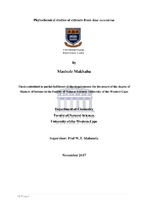Phytochemical studies of extracts from Aloe succotrina
Abstract
Global climate change and geographical differences are two major parameters known to
have, either, direct or indirect influence on the production of secondary metabolites in plants,
which in-turn may affect the quality and/or quantity of the overall metabolites. The primary
purpose of this thesis was to evaluate the phytochemistry of the whole leaf of Aloe succotrina
Lam. spp. - a South African native plant - through a chromatographic spectroscopic
approach-against available data accumulated for the cultivated population. Preliminary
screening of the crude extracts i.e. HEX, DCM and EtOAc on TLC aluminium plates precoated
with silica gel 60 F254 followed by various chromatographic separation, led to the
isolation of five known compounds: ?-sitosterol (1) and two anthrone-C-glycosides (2 and 5),
including two coumarin derivatives-the aglycone (3) and glycoside derivative (4). Notably,
apart from 5 and 2, the accumulation of 1, 3 and 4 in A. succotrina Lam. spp. is reported for
the first time. Structural elucidation of the individual compounds was achieved by extensive
spectroscopic analysis i.e. MS, IR, 1H and 13C-NMR spectroscopy and in some cases
comparison to the literature. A comparative HPLC chromatogram of the crude MeOH extract
of the leaves of A. succotrina Lam. was developed for qualitative (and quantitative)
identification of the active metabolites, which could be realized by VWD with detection at
290 nm.

